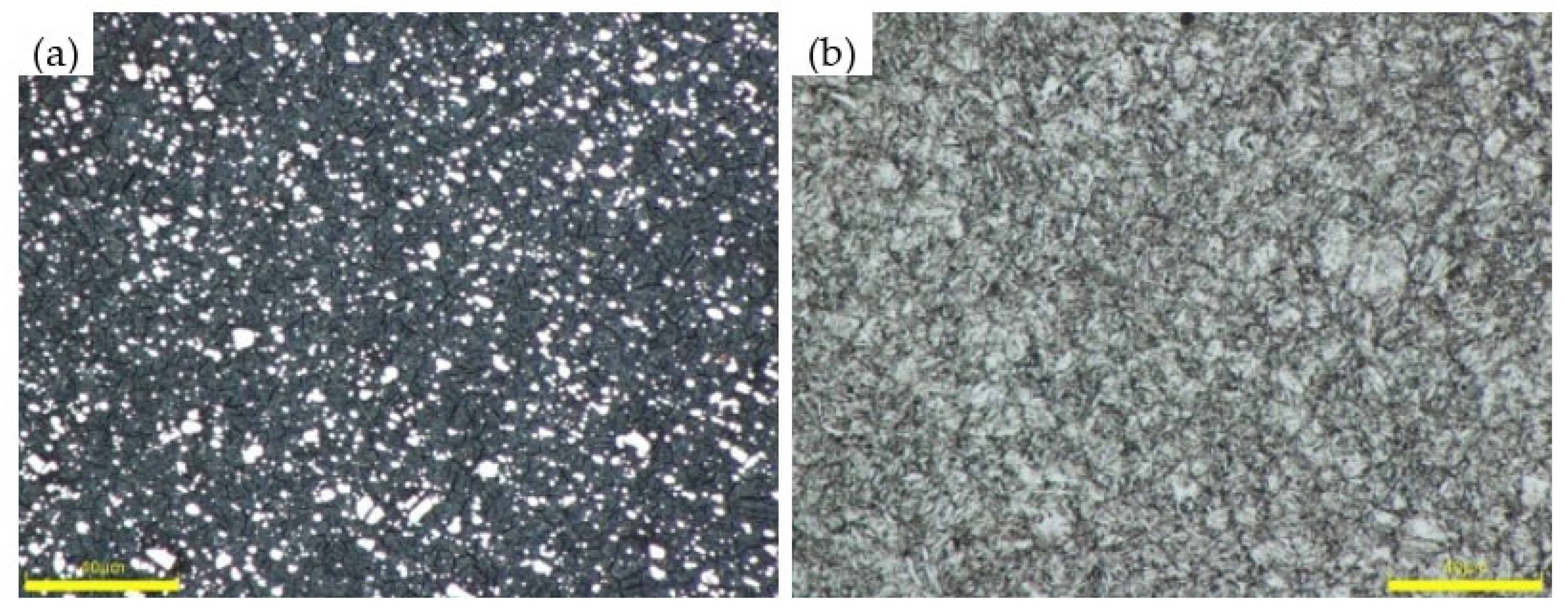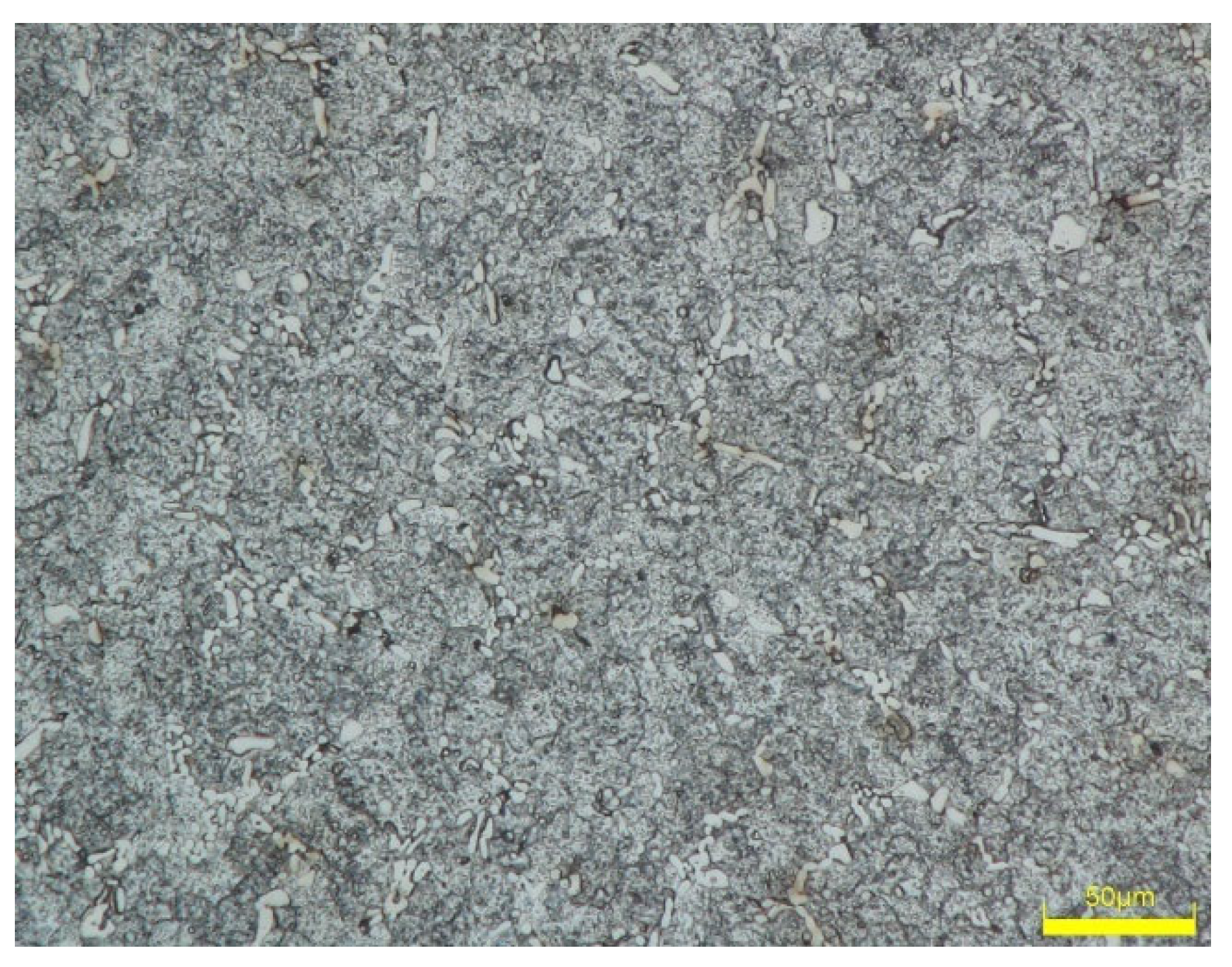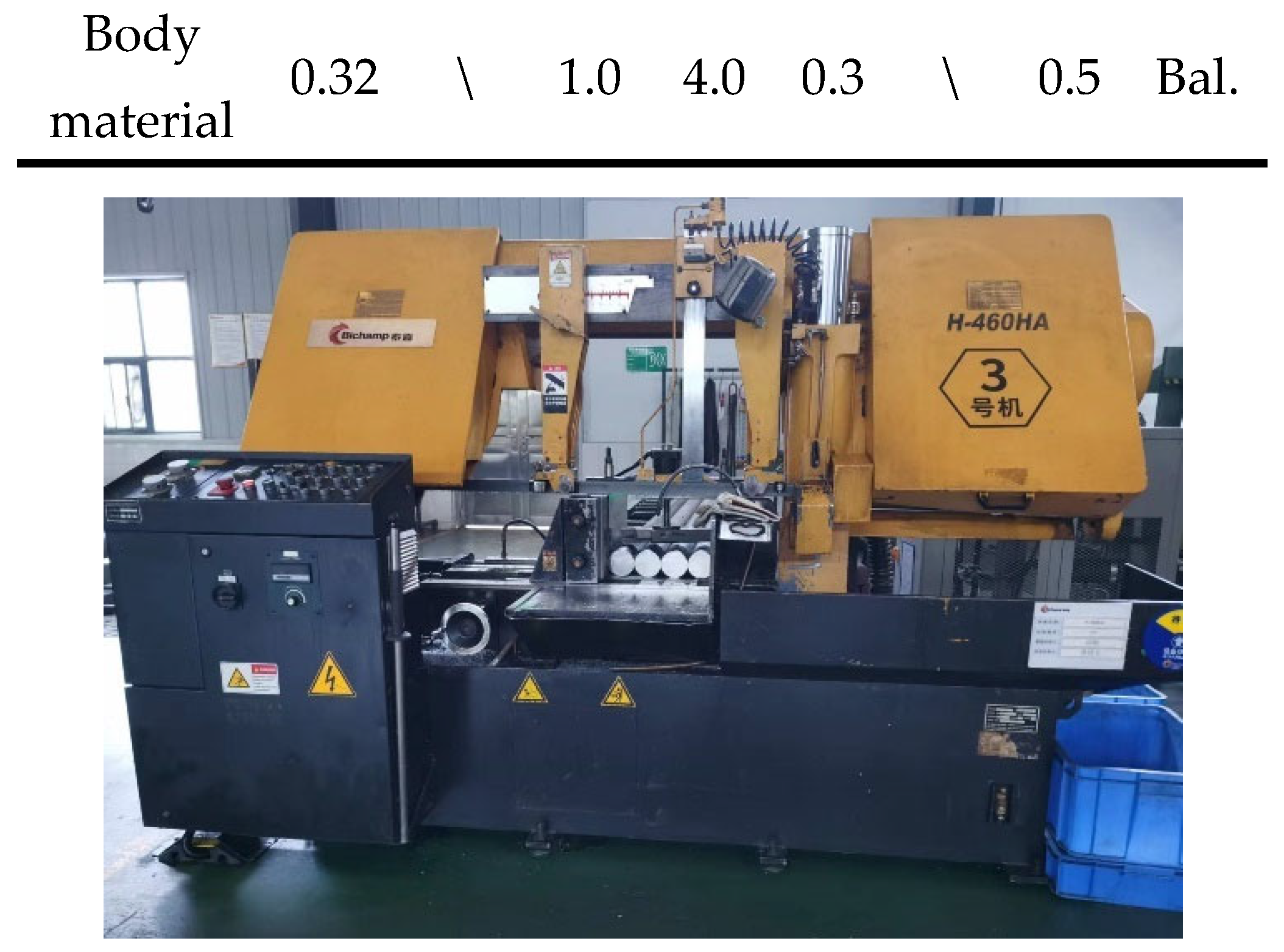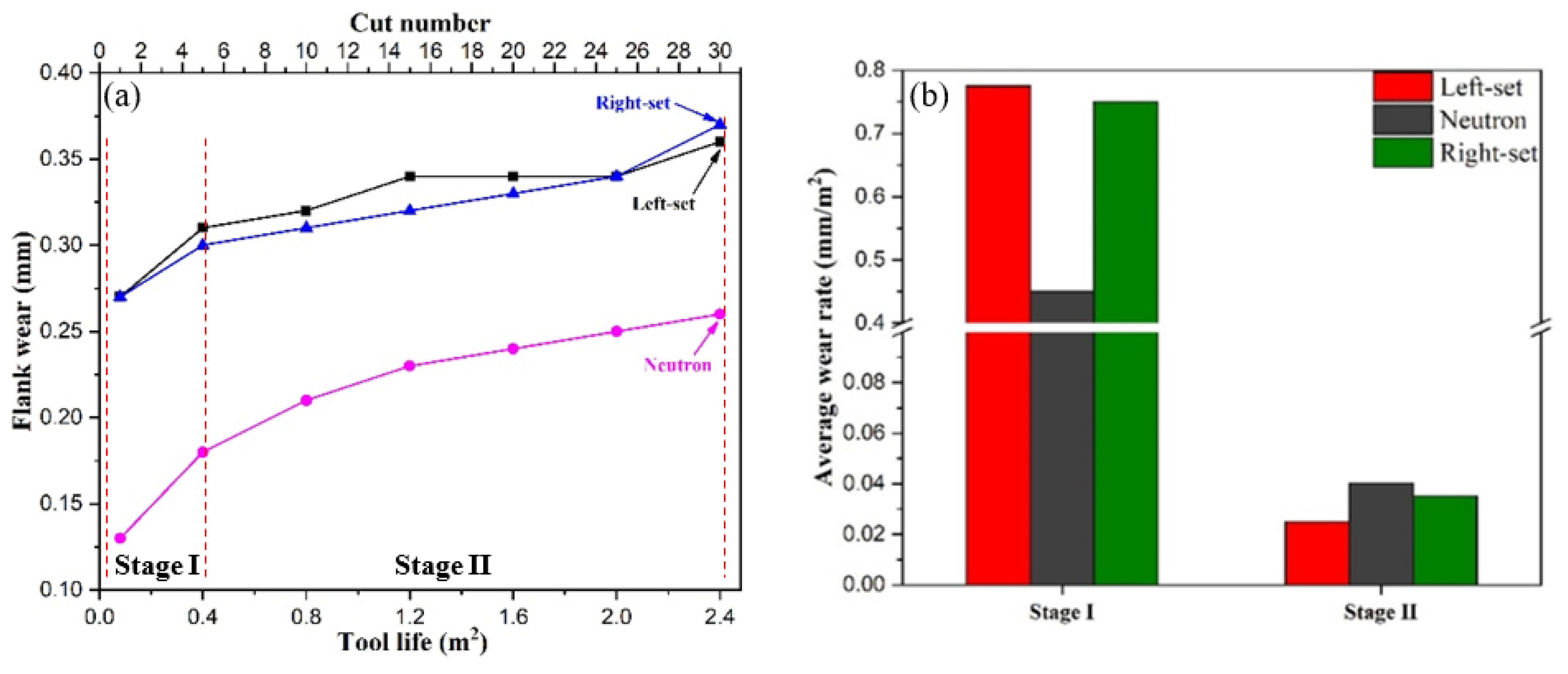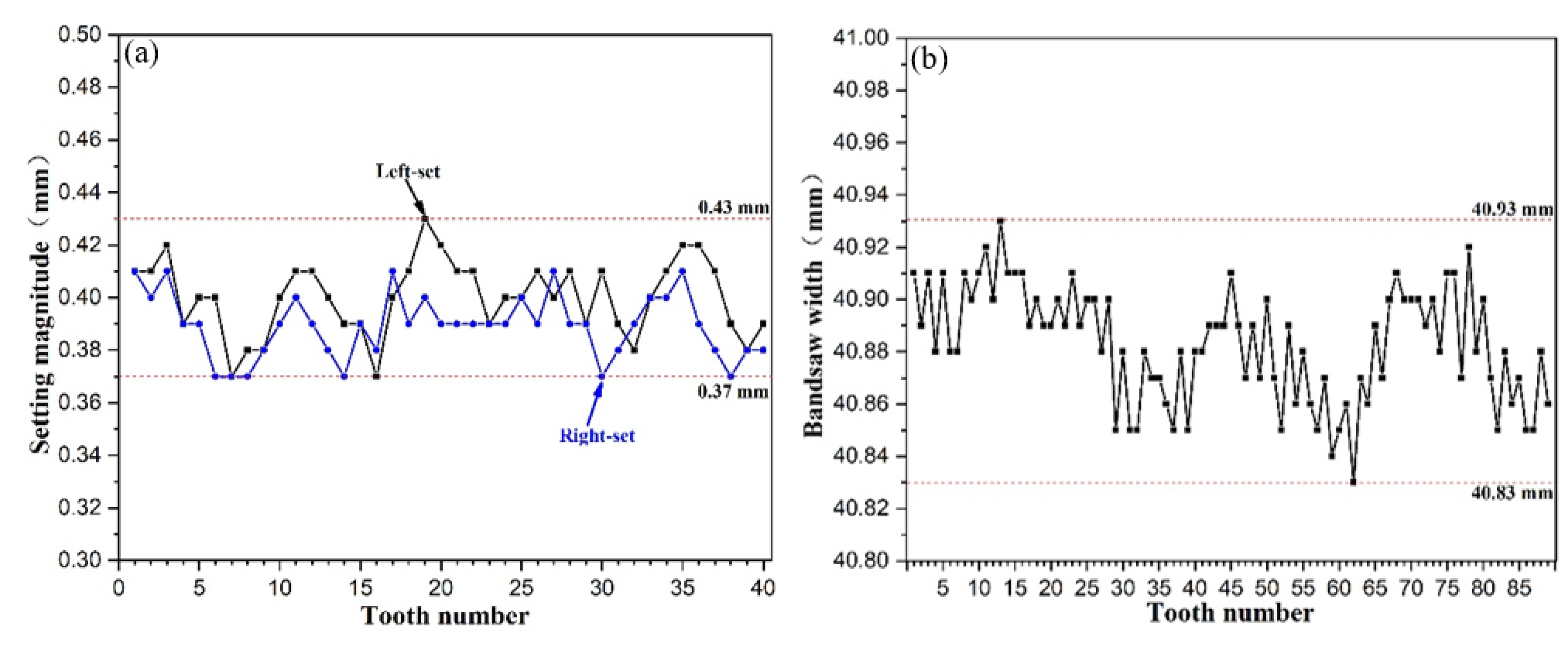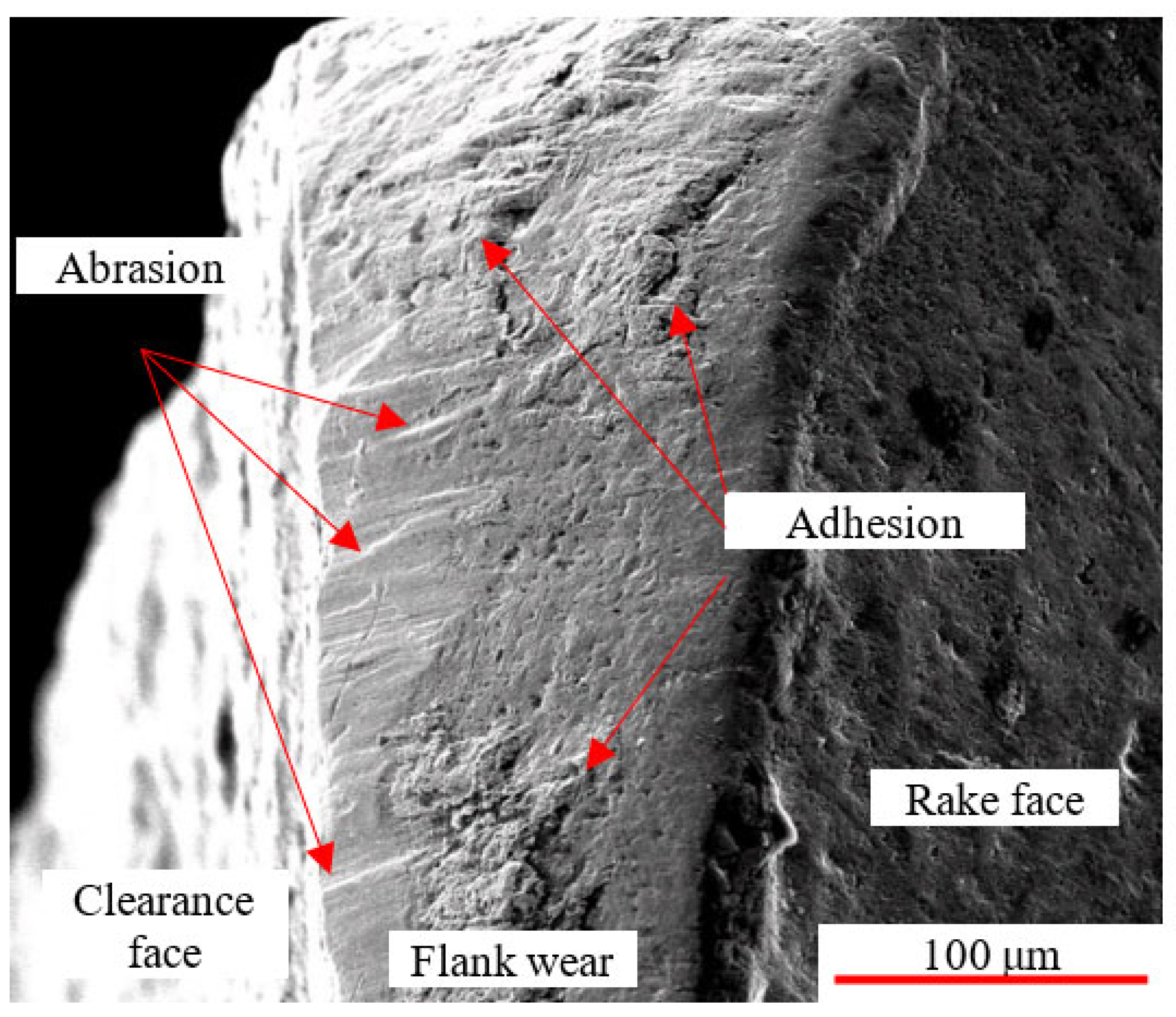3.1. Wear Curve of the Saw Tooth
Starting from sawing 0.08 m
2 (sawing the first cut), the bandsaw was removed after every five cuts for flank wear measurement. The wears of the neutron, left-set, and right-set teeth were measured, and the flank wear evolution is shown in
Figure 4a. The bandsaw employed in the sawing test finally failed after sawing 2.4 m
2, and the failure mode was that the out-of-square was more than 3 mm, which was due to the large wear of the teeth after sawing 2.4 m
2, and the flank wear of the neutron, left-set, and right-set tooth reached 0.26 mm, 0.36 mm, and 0.37 mm, respectively.
As shown in
Figure 4a, the flank wear of the neutron tooth was less than that of the set tooth due to the shape characteristics of different teeth. The wear of both the neutron and set teeth was characterized by two stages: Stage I - sawn area below 0.4 m
2, and Stage II - sawn area over 0.4 m
2. When the sawn area reaches 0.4 m
2, the flank wears of the neutron, left-set, and right-set tooth were 0.18 mm, 0.31 mm, and 0.30 mm, respectively, which is 69.2%, 86.1%, and 81.1% of those of the failed bandsaw, while the tool life percentage at this time is only 16.7% (= 0.4/2.4 × 100%). After the sawing area exceeded 0.4 m
2, the tooth wear entered Stage II, when the wear rate decreased significantly. The average wear rates of the neutron, left-set, and right-set teeth at this stage were 0.04 mm/m
2, 0.025 mm/m
2, and 0.035 mm/m
2, respectively (as shown in
Figure 4b).
Common tool wear curves are characterized by three stages: rapid wear in the first stage, uniform wear in the second stage, and severe wear in the later stages [
18,
19]. However, in this study, the bandsaw teeth did not exhibit severe wear in Stage III because bandsaw blades, which are flexible cutting tools, fail mainly because of out-of-square or body fracture. When teeth are severely worn, the feed force will increase, forcing saw blade body bending. When the bending reaches a critical value, out-of-square wear will occur. At this time, the tooth wear has not entered Stage III (severe wear stage). If out-of-square wear does not occur, the saw teeth will be violently worn (the third stage of wear), and the so-called “domino stripping of teeth” phenomenon will occur, which did not appear in this study.
3.2. Saw Tooth Wear Mechanism in Stage I
To explore the mechanism of tooth wear in Stage I, the bandsaw was removed after one cut for morphological observation. A total of 200 teeth were randomly selected from the entire bandsaw for observation, and significant differences were found in the wear modes of the different teeth. For the purpose of discussion, the wear modes of teeth at this stage were divided into four types.
The first type is mild wear without chipping, as shown in
Figure 5a. It is characterized by a small amount of saw tooth wear (usually flank wear below 0.1 mm), while no wear is found on a few saw teeth, indicating that they are not cut with the workpiece. The saw teeth were relatively intact without chipping. Eleven of the 200 teeth were found to be worn with such characteristics, accounting for 5.5%.
The second type is significant wear without chipping, as shown in
Figure 5b. Compared with the first type, the wear of this type is larger, usually over 0.1 mm, and a built-up edge (BUE) can be observed on several teeth. However, the integrity of the teeth is good, and no chipping is seen. A total of 64 teeth with these characteristics were identified, accounting for 32% of the total.
The third type is chipping, as indicated by the red arrow in
Figure 5c. In this type of wear, teeth were observed to be chipped. The chipping positions of some teeth were in the middle, and those of other teeth were on the corners. However, the common feature was that the chipping width was no larger than 1/2 of the width of the tooth, usually being between 1/5 and 1/3. This type of wear accounted for the largest proportion of the saw teeth (107 saw teeth, or 53.5% of the total).
The fourth type is tooth breakage, such as the position indicated by the red arrow in
Figure 5d. This wear type of saw tooth is seriously damaged. Both sides of the corner have large breakage, the size of the gap accounts for more than 1/2 of the width of the saw tooth, and in extreme cases, a completely broken saw tooth can be seen. A total of 18 serrations with such wear characteristics were found, accounting for 9%.
The phenomenon that different saw teeth of a bandsaw are worn in different modes is probably due to the different cutting depths, resulting in the different cutting forces of different teeth. When a saw tooth is subjected to a large force, the third and fourth wear types are inclined to occur, and when a saw tooth is subjected to a small force, the first and second wear types are more likely to occur. To verify the assumption above, high-speed photography was used to obtain a real-time picture for in situ observation during bandsawing by a new saw blade, as shown in
Figure 6. Large differences were found in the cutting depths of different teeth. Some of the teeth had larger cutting depths and formed thicker chips, as shown in
Figure 6a. In this case, the cutting force of the teeth was high, causing significant wear or chipping, and in extreme cases, tooth breakage could occur. The cutting depth of some of the teeth was relatively small, and the formed chip was fine and thin, as shown in
Figure 6b. In this case, the cutting force was relatively small, the corresponding wear was mild, and the saw teeth were only slightly worn, as shown in
Figure 5a. In the high-speed photographic observations, a few teeth were found not to be in contact with the workpiece, as shown in
Figure 6c, and thus did not cut the workpiece; consequently, tooth wear did not occur.
This phenomenon is probably due to the bandsaw processing accuracy. For bimetal bandsaws, the teeth are usually shaped by a milling cutter followed by a setting process to form neutron teeth, left-set teeth, and right-set teeth. In the case of milling, production is stroke by stroke rather than continuous, where the stroke length is determined by the length of the milling cutter [
20], and a joint will be formed between two adjacent strokes. The accuracy of the joint will affect the accuracy of the bandsaw. Meanwhile, the milling cutter will also experience wear during use, and as the milling cutter edge becomes worn, the width of the bandsaw during formation processing will change (usually, the width will gradually increase). The milling cutter needs resharpening when worn to a certain extent, and the width before and after resharpening is likely to alter. All these factors will affect the accuracy of the bandsaws. Similarly, tooth setting processing is affected by several factors, such as equipment rigidity, operator experience, and wear of the tooth setting tool. To determine the deviation of the width of the bandsaw (distance from the tooth tips to the bottom edge) and the actual accuracy of tooth setting, the widths of 89 consecutive teeth of the new saw blade, 40 consecutive left-set teeth, and 40 consecutive right-set teeth were measured, as shown in
Figure 7. The width of the bandsaw fluctuated from 40.83 mm to 40.93 mm, i.e., within a range of 0.1 mm (as shown in
Figure 7a), and the setting magnitude varied from 0.37 mm to 0.43 mm, i.e., within a range of 0.06 mm (as shown in
Figure 7b). The average depth of cut per tooth is usually small and is only 2.5 μm (i.e., 0.0025 mm) in this study or only 1/40 of the width fluctuation range and 1/28 of the setting fluctuation range. Fluctuations in the width and setting magnitude are inclined to result in different cutting depths of different teeth. The tooth with a relatively small width and small setting magnitude withstands a small cutting depth, and in contrast, a large cutting depth occurs on the tooth with a relatively large width and small setting magnitude, which is easily chipped or broken.
As a multi-point cutting tool, the cutting depths and forces on different teeth of a new bandsaw should ideally be uniform. However, the actual cutting depths and forces of different teeth vary due to the processing accuracy of the bandsaw. Thus, the saw teeth were worn in different types. For most of the saw teeth, because of the relatively large cutting depth, the cutting resistance was large, so the saw teeth wore quickly, and chipping or breaking tended to occur. Chipping is the main wear type, and it is the main reason for the rapid wear of the bandsaw blade in Stage I. After Stage I (rapid wear), the wear of saw teeth entered Stage II (stable wear) due to the even saw teeth after wear in Stage I.
3.3. Saw Tooth Wear Mechanism in Stage II
When the saw tooth wear enters Stage II, the different saw teeth become even until the bandsaw blade fails. Except for seriously damaged saw teeth in Stage I, most of the remaining saw teeth eventually present uniform wear, as shown in
Figure 9. However, because of the specificity of the distribution of the bandsaw blade teeth, different teeth form kerfs at different positions, leading to differences in their wear characteristics. For neutron tth, both sides of tooth are worn more severely than the central part of tooth, forming an arc shape after uniform wear, as shown in
Figure 8a. For the set tooth, the major part that withstands wear is the outside of the saw tooth, that is, the left side of the saw tooth for the left-set tooth and the right side of the saw tooth for the right-set tooth. Therefore, the set tooth is mainly unilateral wear, as shown in
Figure 8b and
Figure 8c, which meets the results of research by Sӧderberg et al. [
21].
In Stage II, the saw teeth gradually become even, so chipping of the saw teeth infrequently occurs, and the wear of the saw teeth presents a wear mechanism different from that in Stage I. The SEM images of the bandsaw blade teeth after failure are shown in
Figure 9, which exhibits two different tooth wear mechanisms in Stage II. Obvious adhered workpieces are observed, and most of them are tightly adhered to the saw teeth. However, some of the large adhered workpieces have cracks between them and the saw teeth, indicating that they are about to peel off. The parts show the characteristics of adhesive wear. Meanwhile, small scratches exist on the worn surface of the saw tooth, and the direction of the scratches is consistent with the cutting direction, which presents abrasive wear. The workpiece material (Cr12MoV cold-work die steel) used in this study is high-C, which is a high-Cr martensitic stainless steel with a C content of approximately 1%. Thus, there are more carbides with high hardness on the matrix. These carbides abrade the saw teeth during bandsawing, so the bandsaw blade teeth develop abrasive wear. In summary, adhesive and abrasive wear are the main wear mechanisms of the bandsaw blade teeth in Stage II.
3.4. Suggestions for Improving the Sawing Performance of Bandsaws
As mentioned above, the wear of bandsaw teeth when sawing Cr12MoV is divided into two stages: Stage I-rapid wear stage, during which the wear mechanism is characterized by chipping being dominant and various forms of wear coexisting; and Stage II-homogeneous wear, during which adhesive and abrasive wear are the main wear mechanisms. Therefore, suppressing chipping in Stage I and adhesive and abrasive wear in Stage II are the main methods for improving the sawing performance of bandsaws.
Edge preparation of saw teeth by sandblasting was previously proposed to reduce the previous chipping of bandsaw teeth [
22,
23]. Since bandsawing features a small cutting depth of a single tooth (the average cutting depth of a single tooth in this study was 2.5 μm, while the cutting depths of other methods such as turning, drilling, and milling are usually more than 100 μm [
24,
25,
26]), the edge radius of bandsaws should not be too large, which distinguishes it from other cutting tools. The main reason for chipping in Stage I is the large tolerance of the processing accuracy of the bandsaw blade (greater than the cutting depth of a single tooth); thus, improving the processing accuracy of the bandsaw blade is an effective way to reduce chipping. A method to manufacture a bimetal bandsaw blade by CNC grinding instead of milling was proposed to improve the width accuracy of the bimetal bandsaw blade from 0.1 mm (as shown in
Figure 6a) to ≤0.05 mm [
27]. Break-in procedures are widely used in bandsawing, especially for hard-to-machine materials with a high rate of work hardening, such as stainless steel and superalloys. When executing the break-in procedure, the operator needs to decrease the feed rate to reduce the average cutting depth per tooth and then reduce the cutting force. Then, the feed rate is increased gradually to the normal value after some time. However, there are many factors that will influence the break-in procedure, such as the bandsaw’s quality, stability of the bandsaw machine, and workpiece, and operators generally perform the break-in procedure based on their own experience.
Adhesive and abrasive wear are the main wear mechanisms of Stage II, so improving the wear resistance of the saw teeth is beneficial for reducing the wear during Stage II. The application of powder metallurgy HSS instead of traditional HSS is effective; for example, ASP2042 [
28] and ASP2051 [
29] are better options for saw tooth materials. PVD technology has been broadly used for various tools, such as lathing tools, milling cutters, drills, and circular saws. Researchers have tried to apply PVD technology to improve the sawing performance of bandsaws, and the life of bandsaws has obviously improved [
14]. However, unlike other tools, PVD coating is not widely utilized in bandsaws at present due to its high cost and the special shape of bandsaws.
